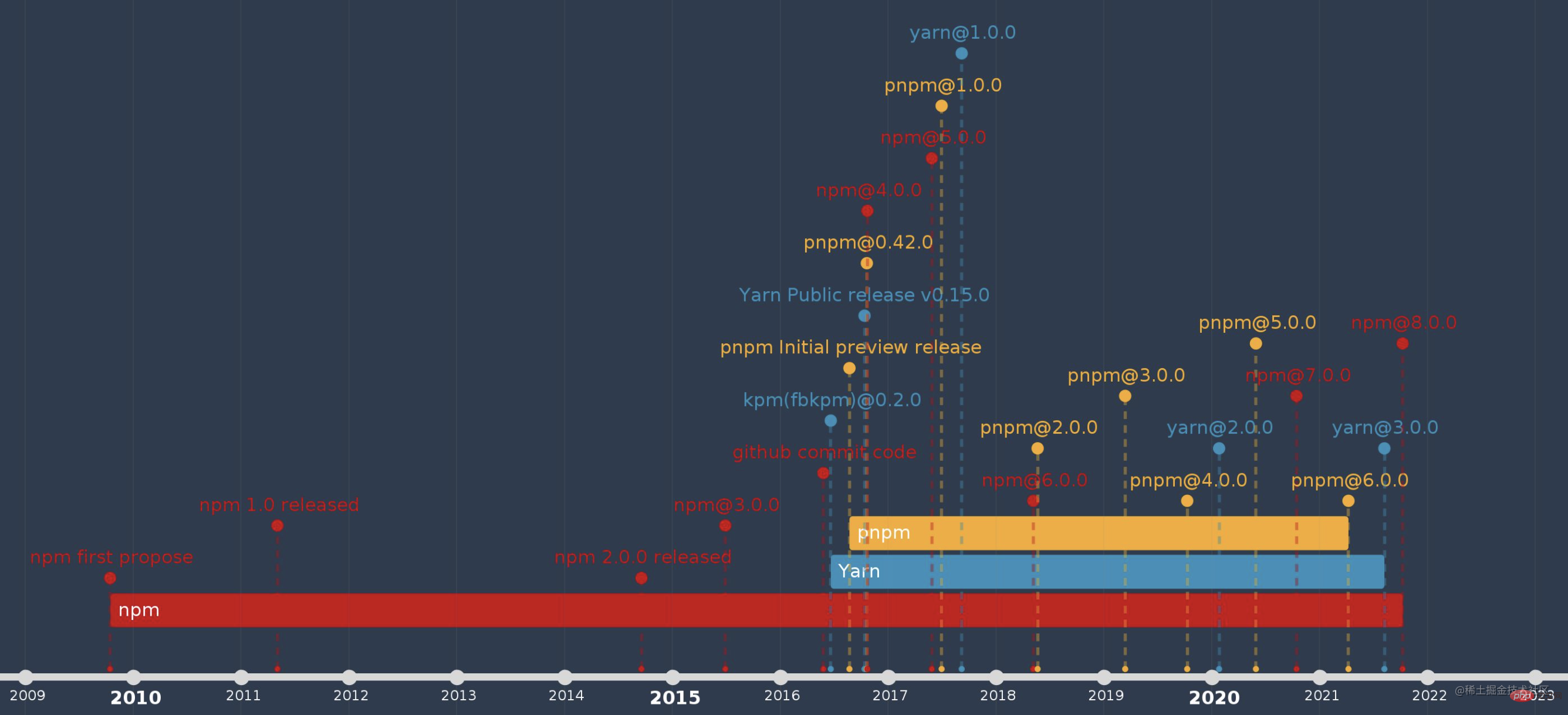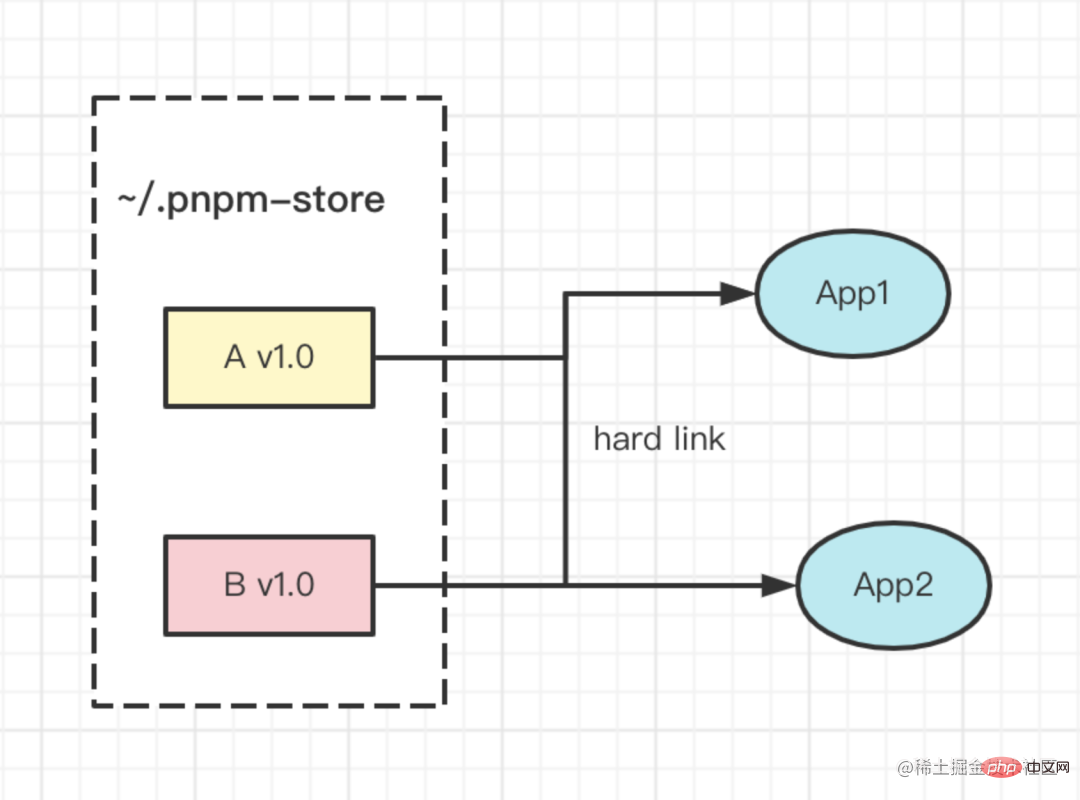
Since the birth of Node in 2009, the Node ecosystem has developed and prospered. Node package managers derived from the Node ecosystem have flourished, and npm, kpm, pnpm, yarn, cnpm, etc. have appeared successively. In fact, the development of the Node package manager is mainly divided into 5 stages. Let's take a look at the key features and representative products of each stage~

To be precise, Node did not exist without a package manager. In 2009, when Node.js came out, the prototype of npm was also released. . [Related tutorial recommendations: nodejs video tutorial, Programming teaching]
npm’s full name is Node.js Package Manager; from A brief history of Node.js You can see it inside
2009 Node.js is born The first form of npm is created
Let’s talk about what it was like when the Node package manager didn’t appear. What I did more at that time was
Looking online The official website of each software, such as jQuery;
Find the download address and download the zip package;
Unzip it and put it in a project called libs directory;
If you want to make it more convenient, paste the CDN link directly into the HTML
Modular management at that time? Version number management? Depend on upgrade? None of them exist!
In 2009, Node.js was born, and the prototype of npm was also brewing. Version 1.0 was released in 2011; npm is built around Semantic version control is designed with the idea of semver. By default, Node package developers will upgrade the version number according to semver specifications when upgrading the custom version number of dependent packages.
Pronoun: Node package management standardization, node_modules directory nested storage dependencies
Representative products: npm v1, v2 version
Key features:
(1) Nested installation of dependent packages, dependencies of the same version will be installed redundantly
(2) Uncertainty of dependent package installation: The latest version of the dependency package is installed by default (a fixed version can be set)
(3) Serial installation of dependencies is slow; offline caching is not supported
Explanation 1: Dependencies Nested installation , if A depends on B and B depends on C, the node_modules directory is as follows
node_modules - package-A -- node_modules --- package-B ----- node_modules ------ package-C -------- some-really-really-really-long-file-name-in-package-c.js
Problem: Too many dependencies will be nested. This causes nesting hell. At the same time, there will be a large number of redundant installations of the same dependent packages, causing node_modules to be too large, requiring programmers to regularly rm -rf node_modules. However, in Windows systems, many programs cannot handle file paths exceeding 260 characters. Name, early Windows users of npm have seen this pop-up window

##Explanation 2: For each npm install, the latest version of dependencies is installed by default, causing Dependency installation Uncertainty Problem:
semver standardizes the version number composition: X.Y.Z-[state], the version number upgrade specifications are as follows
Solution 1: You can use the npm config set save-exact true command to turn off the use of ^ in front of the version number. Default behavior
npm v3 version
Brief description of the principle: When npm install, first build the dependency tree and then install all dependencies in the node_modules root directory. When sub-dependencies encounter different versions of dependencies with the same name, they will be installed in Under your own node_modules
Key features:
(1) Reduce redundant installation: rely on flat installation, which reduces the installation of redundant packages under certain circumstances
Existing problems:
(1) "Ghost dependency", "Phantom dependency" Problem
(2) "Twin strangers", "Dependency package" "Clone" problem
(3) The directory is not fixed: the installation order of dependencies determines the node_module directory structure
Explanation 1: The installation order of dependencies determines the node_modules directory structure
The following scenario: App1 depends on packageA and packageC and packageG and packageH, and packageA and packageC both depend on packageB v1.0, and packageG and packageH both depend on packageB's v2.0 version
If you install packageA or packageC first, the node_modules directory is as follows

If you install packageG or packageH first, the node_modules directory is as follows

In response to the above situation, npm provides the command npm dedupe, which can manually organize & simplify the directory structure of node_modules. The organized directory structure of node_modules is consistent and is not affected by the installation order of dependent packages.
Explanation 2: It may not necessarily reduce the installation of redundant packages
Through Example 1, it can be seen that although dependent packages are installed flat, the same version still exists Dependent packages, there are redundant packages
Explanation 3: "Twin Strangers" Problem
Refer to example 1, the same version of dependent packages is installed twice, is placed in two places, this phenomenon is called "twin strangers"
Explanation 4: "Ghost dependency" Problem
node_modules Dependencies in the first-level directory Packages can be used directly by developers, but the dependency packages are not defined in package.json. Such dependency packages are called "ghost dependencies". If "ghost dependencies" are used in front-end projects, problems may occur later.
Because this "ghost dependency" may be removed later along with the upgrade of other dependencies, it will no longer exist in node_modules. When executing npm install, the "ghost dependency" will not be installed subjectively. As a result, the project cannot find dependent packages and then reports an error.
In 2016, yarn and pnpm release versions appeared one after another, which to a certain extent solved the uncertainty of the previous installation version and the installation speed. Compared with npm, yarn's first capabilities are more eye-catching, ensuring consistency & security, and improving installation speed
Synonyms: Dependent installation is relatively safe, Speed up
Representative products: yarn release version, pnpm release version, npm v5 version (npm v4 has not changed much, v5 has taken a big step forward)
Key features:
(1) Security: The version lock file is generated by default, ensuring that the dependent version is the same every time you install it
(2) Speed up: Added offline cache Installation, parallel installation, automatic retry after installation exception
(3) workspace: yarn is supported from v1 version, and can efficiently manage the dependency packages of multiple projects; npm v7 only supports workspace
Existing problems:
(1)Ghost dependency
(2)Repeated installation of single-project and repeated installation of dependency packages across projects
(3) The directory is not fixed: the installation order of dependencies determines the node_module directory structure
Explanation 1: About security
yarn v0.x version takes the lead, npm v5.x version follows Subsequently, when downloading dependencies, a dependency lock file is generated by default, which accurately locks the version at a value of
Summary: Avoids the need to install dependencies on different terminals Version inconsistency problem, but the "ghost dependency" problem still exists
Explanation 2: About speed improvement - offline caching
npm v2 version supports caching, but requires online detection , to use cached dependencies
yarn v0.x version is the first to support offline caching. Packages downloaded from the network will be cached globally. The next installation will give priority to searching locally and copy directly if found
npm v5 version rewrites the cache system and also supports offline installation, greatly improving the installation speed
Explanation 3: About speed-up - parallel installation
yarn was the first to support dependencies Packages are installed in parallel. Previously, npm installed dependencies serially. Later, npm also optimized parallel installation
Explanation 4: After installing dependencies, the node_modules directory is automatically organized
Start time :yarn v1.x version, npm v4.x version
.lock file is deleted from the project, the node_modules directory will be automatically sorted out when the dependencies are initially installed; for versions prior to npm v4.x, the user needs to manually execute the instructions npm dedupeOrganize the dependency directoryFacing the maturity of pnpm, developers are enjoying the dividends brought by pnpm such as safer, higher speed, and lower storage consumption, solving the problem of "ghost dependency" and solving the problem of repeated dependency
Pronoun: Safe (depending on installation WYSIWYG), high speed (no repeated installation), low storage consumption (hard link and soft link)
Representative product: pnpm
Key features:
(1) Extremely fast: The storage center centrally manages dependencies and directly hard links to the project node_modules/.pnpm. Compared with the previous working method, a large number of IO operations from global node_modules copy to the project are reduced
(2) The disk utilization is extremely high:
(3 ) High security: The node_modules directory structure is the package.json dependency list, which solves the "ghost dependency" problem

The performance is as follows:

For more node-related knowledge, please visit: nodejs tutorial!
The above is the detailed content of An article to talk about the five stages of Node package management development. For more information, please follow other related articles on the PHP Chinese website!